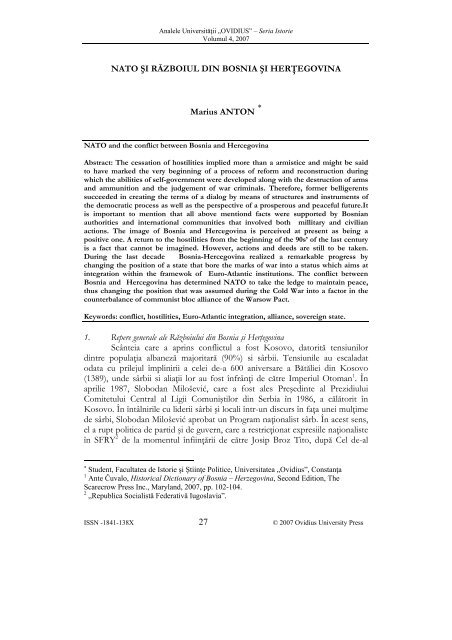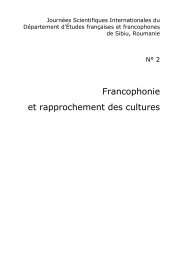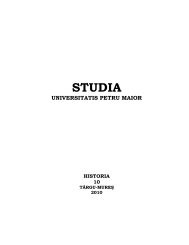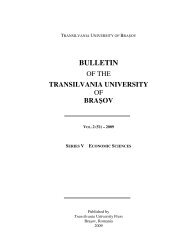„ovidius†constanţa - Biblioteca Universitatii "LUCIAN BLAGA" SIBIU
„ovidius†constanţa - Biblioteca Universitatii "LUCIAN BLAGA" SIBIU
„ovidius†constanţa - Biblioteca Universitatii "LUCIAN BLAGA" SIBIU
Create successful ePaper yourself
Turn your PDF publications into a flip-book with our unique Google optimized e-Paper software.
Analele Universităţii „OVIDIUS” – Seria Istorie<br />
Volumul 4, 2007<br />
NATO ŞI RĂZBOIUL DIN BOSNIA ŞI HERŢEGOVINA<br />
Marius ANTON �<br />
NATO and the conflict between Bosnia and Hercegovina<br />
Abstract: The cessation of hostilities implied more than a armistice and might be said<br />
to have marked the very beginning of a process of reform and reconstruction during<br />
which the abilities of self-government were developed along with the destruction of arms<br />
and ammunition and the judgement of war criminals. Therefore, former belligerents<br />
succeeded in creating the terms of a dialog by means of structures and instruments of<br />
the democratic process as well as the perspective of a prosperous and peaceful future.It<br />
is important to mention that all above mentiond facts were supported by Bosnian<br />
authorities and international communities that involved both millitary and civilian<br />
actions. The image of Bosnia and Hercegovina is perceived at present as being a<br />
positive one. A return to the hostilities from the beginning of the 90s’ of the last century<br />
is a fact that cannot be imagined. However, actions and deeds are still to be taken.<br />
During the last decade Bosnia-Hercegovina realized a remarkable progress by<br />
changing the position of a state that bore the marks of war into a status which aims at<br />
integration within the framewok of Euro-Atlantic institutions. The conflict between<br />
Bosnia and Hercegovina has determined NATO to take the ledge to maintain peace,<br />
thus changing the position that was assumed during the Cold War into a factor in the<br />
counterbalance of communist bloc alliance of the Warsow Pact.<br />
Keywords: conflict, hostilities, Euro-Atlantic integration, alliance, sovereign state.<br />
1. Repere generale ale Războiului din Bosnia şi Herţegovina<br />
Scânteia care a aprins conflictul a fost Kosovo, datorită tensiunilor<br />
dintre populaţia albaneză majoritară (90%) si sârbii. Tensiunile au escaladat<br />
odata cu prilejul împlinirii a celei de-a 600 aniversare a Bătăliei din Kosovo<br />
(1389), unde sârbii si aliaţii lor au fost înfrânţi de către Imperiul Otoman 1 . În<br />
aprilie 1987, Slobodan Milošević, care a fost ales Preşedinte al Prezidiului<br />
Comitetului Central al Ligii Comuniştilor din Serbia în 1986, a călătorit în<br />
Kosovo. În întâlnirile cu liderii sârbi şi locali într-un discurs în faţa unei mulţime<br />
de sârbi, Slobodan Milošević aprobat un Program naţionalist sârb. În acest sens,<br />
el a rupt politica de partid şi de guvern, care a restricţionat expresiile naţionaliste<br />
în SFRY 2 de la momentul înfiinţării de către Josip Broz Tito, după Cel de-al<br />
� Student, Facultatea de Istorie şi Ştiinţe Politice, Universitatea „Ovidius”, Constanţa<br />
1 Ante Čuvalo, Historical Dictionary of Bosnia – Herzegovina, Second Edition, The<br />
Scarecrow Press Inc., Maryland, 2007, pp. 102-104.<br />
2 „Republica Socialistă Federativă Iugoslavia”.<br />
ISSN -1841-138X 27 © 2007 Ovidius University Press









